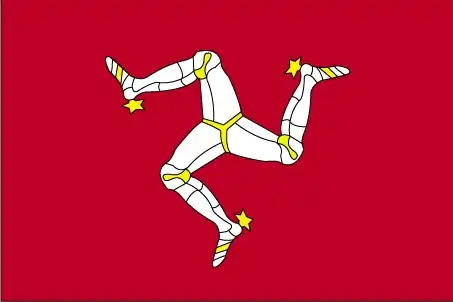Isle of Man Flag
National Flag of Isle of Man
Isle of Man Flag Display

Quick Facts About Isle of Man and flag of Isle of Man
- Adopted:
- Aspect Ratio:
- 5:8
- Capital:
- Douglas
- Population:
- Approximately 85,000 (2023)
Isle of Man Flag - Description
The flag of the Isle of Man features a unique emblem known as the ‘triskelion’—three armored legs bent at the knee, running in a clockwise direction—set against a vibrant red field. This iconic symbol emphasizes motion, unity, and resilience.
Isle of Man Flag – Symbolism and Meaning
Isle of Man Flag - History and Origins
Legend traces the triskelion back to Norse and Celtic influences in the Middle Ages. It emerged on manorial arms and coinage by the 13th century, long before modern flags. In 1932, the current banner was officially adopted to differentiate the Isle of Man flag from other red ensigns, reinforcing Manx identity. Since then, it has become deeply cherished as the Island’s primary national symbol.
Isle of Man Flag - Design Elements
Of a 5:8 ratio, the flag features a bold red backdrop and a central, gold-colored triskelion with three bent legs, each bearing a spurred boot. The emblem is centrally positioned and slightly rotated to symbolize perpetual motion, adhering to strict proportions for recognizability.
Isle of Man Flag - Usage Guidelines and Protocol
Flag use on the Isle of Man follows local legislation and custom: it is flown at public buildings, civic events, and on Tynwald Day (5 July). The banner may be flown alongside the Union Jack but must not share a single flagpole. In times of mourning, flags are lowered to half-mast in accordance with Island tradition.
Frequently Asked Questions
What do the colors of the Isle of Man Flag represent?
The triskelion—three legs conjoined—symbolizes strength, progress, and self-reliance. Each leg stands for resilience through adversity. The symbol’s motto, 'Quocunque Jeceris Stabit' ('whichever way you throw, it will stand'), reflects Manx toughness and identity. The red background denotes courage and vitality.
When was the Isle of Man Flag adopted?
The Isle of Man flag was adopted on 1 July 1932 (officially registered), marking an important milestone in the country's development as an independent nation.
What is the aspect ratio of the Isle of Man Flag?
The Isle of Man flag has an aspect ratio of 5:8, which determines the proportional relationship between its width and height for official display purposes.